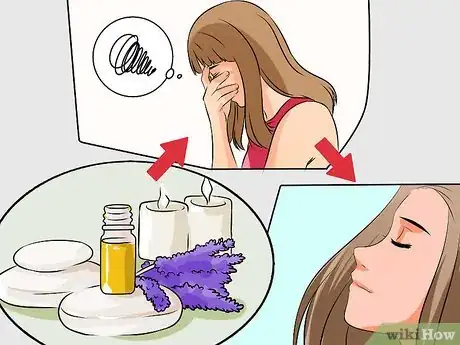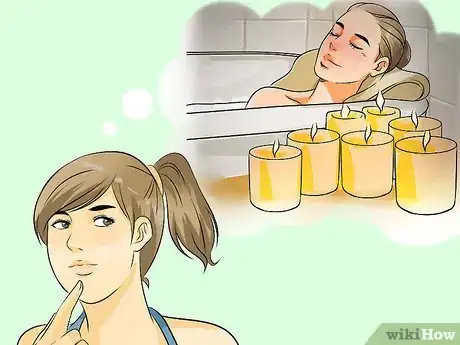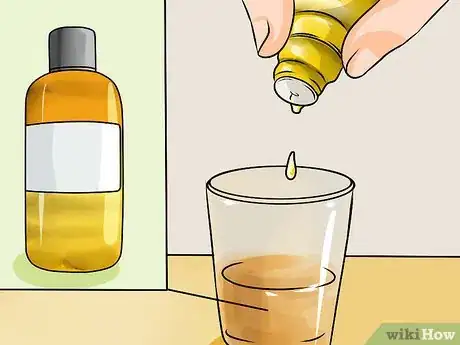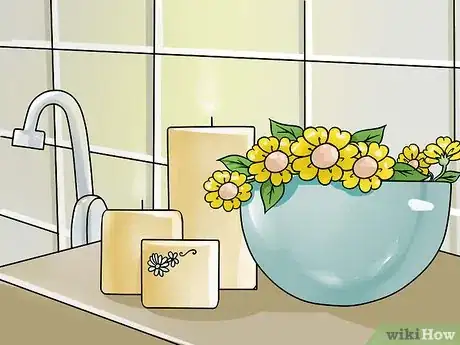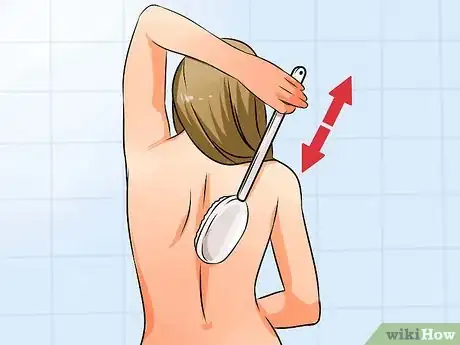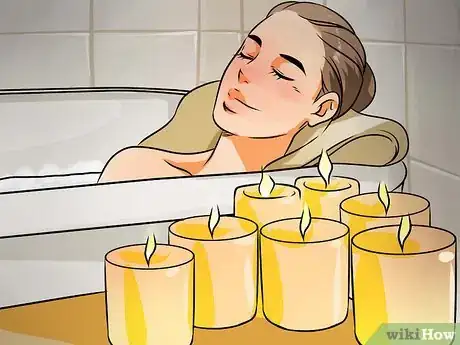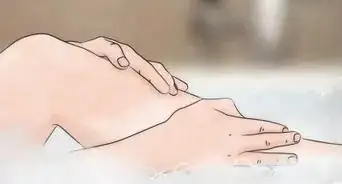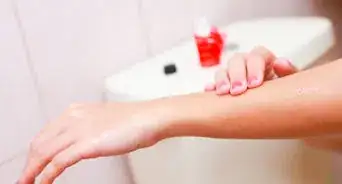This article was co-authored by Ritu Thakur, MA. Ritu Thakur is a healthcare consultant in Delhi, India, with over 10 years of experience in Ayurveda, Naturopathy, Yoga, and Holistic Care. She received her Bachelor Degree in Medicine (BAMS) in 2009 from BU University, Bhopal followed by her Master's in Health Care in 2011 from Apollo Institute of Health Care Management, Hyderabad.
There are 20 references cited in this article, which can be found at the bottom of the page.
This article has been viewed 199,668 times.
Aromatherapy has been used for centuries to relax, revive, and even cure ailments.[1] An aromatherapy bath is at once a soothing retreat, moisturizing treatment for the skin, and reviving experience. There are many ways to enjoy an aromatherapy bath, even if you have sensitive skin. From using essential oils to bath gels and candles and scent diffusers, you or your loved one can easily be on your way to a thoroughly luxurious experience.
Steps
Learning About Aromatherapy
-
1Learn about what aromatherapy is. Used for centuries in cultures across the world, aromatherapy is the use of scent, often through essential oils, to promote psychological and physical well-being.[2] Knowing about the different scents and health benefits of aromatherapy will help you decide the best type of aromatherapy for you.
- Anyone from adults to children can use aromatherapy. However, in very young children, the elderly, and pregnant women, you’ll need to take precautions with using oils and hot water.[3]
-
2Learn about the health benefits of aromatherapy. Essential oils, when inhaled as a scent or applied to the skin, have a variety of health benefits. They can help with physical ailments such as congestion and ease psychological conditions such as anxiety. Learning about the benefits of using aromatherapy can help you choose the best essential oils for your needs.[4]
- Aromatherapy can ease the symptoms of certain physical ailments. For example, using eucalyptus essential oil can help with congestion.[5]
- Aromatherapy can also ease the symptoms of certain psychological ailments. For example, using lavender or chamomile essential oils can help with anxiety and depression.[6]
- In general, using aromatherapy, especially when in conjunction with a warm bath, will relax and soothe you.[7]
Advertisement -
3Understand what essential oils are. Essential oils are distilled from the leaves, stems, flowers, bark, or roots of a specific plant and contain its true essence. They are neither oily nor are they like a fragrant oil.[8]
-
4Find the right essential oil for your needs. You will use different essential oils in your bath depending on what you wish you achieve with your aromatherapy bath—relaxation and calming or easing ailments. Each oil has different properties and knowing what these are will help you make the best choice for your needs.
- Keep a selection of different essential oils at hand so that you can use them whenever you want or need.
- Bergamot essential oil can help stress, depression, anxiety and some skin infections such as psoriasis and eczema.[12]
- Chamomile essential oil is a powerful calming agent. In addition to being an antiseptic, it can also help lift mood and aid depression.[13]
- Eucalyptus essential oil can help with respiratory issues, fevers, and headaches and is a stimulant. It also has cooling and deodorizing properties.[14]
- Jasmine essential oil can help reduce tension and stress. It may also help ease childbirth, depression, and respiratory issues.[15]
- Lavender essential oil is an excellent choice to relieve stress, but can also be used as an anti-depressant, deodorant, and sedative.[16]
- Lemon essential oil can help improve concentration, digestion, and ease the symptoms of acne.[17]
- Marjoram essential oil can help ease anxiety and stress, fight fatigue, and may alleviate respiratory and circulatory issues.[18]
- Rose essential oil can help with depression, anxiety and digestion. It may also aid circulation and respiratory conditions such as asthma.[19]
- Tea tree essential oil is an antiseptic that can heal burns and cuts and soothe cold sores and muscle aches.[20]
- For a comprehensive list of essential oils and their properties, visit the website at http://www.aromaweb.com/essentialoils/default.asp#essentialoilprofiles .
-
5Use a carrier oil with your essential oil. Because essential oils are so concentrated, you’ll need to dilute it with a carrier oil to best use it. You can use a variety of different plant oils as a carrier oil including: sweet almond oil, apricot kernel oil, avocado oil, olive oil, and sesame oil.[21] These often have the added benefit that they effectively moisturize skin.
- Make sure to use a natural, plant based oil. These pair best and most effectively with essential oils. Sweet almond oil, apricot kernel oil, avocado oil, olive oil, and sesame oil are excellent carrier oils.[22]
- Don’t use water or other liquids to dilute your essential oil, which will make it difficult to use it effectively for your aromatherapy bath or shower.
-
6Be an informed user of essential oils. Because each essential oil has different properties and may not be ideal for all users, it’s important to read the properties of any essential oil before you use it. It’s also a good idea to do a skin patch test before using an oil as well.
- By reading the bottles of essential oils, you can find out about the oil’s now the contra-indications. For example, you wouldn’t want to use eucalyptus oil if you are pregnant, breast feeding, or an epileptic.[23]
- Not reading the contra-indications of an essential oil can have a serious affect on your health.
- Before you use the essential oil in a bath, do a skin patch test. Add 1-2 drops of diluted essential oil to the inside of your elbow. Leave it on and if no irritation occurs after 24 hours, then you can safely use the essential oil in a bath on your skin.[24]
-
7Decide on a delivery method. There are different methods to deliver essential oils for aromatherapy. From using the essential oils in a bath to heating them with a scent diffuser, you’ll want to choose the most optimal type of method for you.
- Essential oils, which are mixed with a carrier oil, in a bath are one of the best ways to use aromatherapy.
- Because some people have sensitive skin, using an essential oil in bathwater may be too intense. In these cases, people can use heated scent diffusers to reap the benefits of aromatherapy.
-
8Spritz it on your towel. If you don’t want to put an essential oil on your skin because it is sensitive, for example, you can spritz it on your towels. The scent will help you relax and may help induce sleep.
- Making a spritzer for your towels is easy. Simply take 30-40 drops of your favorite essential oil for sleep and add 1.5 ounces of distilled water. Mix these in a clean spray bottle and then lightly spray on your towels.[25]
- The number of drops of essential oil you use will depend on how strong you want the scent to be.[26]
- You only need to lightly mist your towels to get the benefits of essential oils. Dousing your towels may irritate your skin.
Taking an Aromatherapy Bath
-
1Choose an oil and mix it with the carrier oil. Before you can enjoy the luxury of an aromatherapy bath, choose an essential oil or bath gel depending on what you need. You may want to relax, energize yourself, or ease a physical ailment. You’ll then need to mix the essential oil with a carrier oil of your choice.
- If you couldn’t find a specific essential oil, feel free to use scented bath gels, salts, or bath bombs. You can also try these options if your skin was irritated by the essential oil, though consider that bath gels, salts and bombs may have the same effect.[27]
- In order to use the essential oil in your bath, mix it with the carrier oil of your choice. The best mixture is about 7-12 drops of essential oil to each fluid once of carrier oil, depending on how strong you want the aroma.[28]
-
2Draw a bath. Now it’s time to fill your bathtub with the water and your essential oil so that you can enjoy the full benefits of aromatherapy. Make sure the water isn’t too hot so that you can relax and add your oil as the water fills to get the best distribution of your essential oil.
- If you don’t have a bathtub, just put your diluted essential oil on a sponge and wash as usual, making sure to take deep breaths.
- Make sure that the water isn’t too hot when drawing your bath so that you don’t burn your skin. You can use a thermometer to check for optimal water temperatures for anyone. Some of the best temperatures for different people are: between 37 and 38 degrees Celsius for babies and children[29] ; between 37 and 39 degrees Celsius for the elderly[30] ; between 37 and 38 degrees Celsius for pregnant women[31] ; and between 36 and 40 degrees Celsius for most other people.[32]
- Add your essential oil to the running water to distribute it through the bathwater.
- If you’re not using an essential oil in your bath, consider using some whole milk in the water to soothe and moisturize your skin.
-
3Set a comfortable and relaxing mood. Most people who are taking aromatherapy baths use it for relaxation, but even if you are looking to energize yourself, you’ll want to make your bathroom as comfortable and relaxing as possible by using such things as music, bath props, and candles.
- Aromatherapy candles and scent lamps are a great way to reinforce the properties of your essential oil. In addition, their soft light will help to further relax you.[33] Both are widely available at major retailers and online.
- Aromatherapy candles and scent lamps are an excellent alternative to using essential oils if you have sensitive skin.[34]
- Dim the lights in the bathroom, but don’t turn them off completely unless you’re using candles.
- Soft music can help set the mood for you to relax and reinvigorate yourself.
-
4Dry brush your skin before getting stepping in the bath. Use a loofah or skin brush to brush your skin before you get in the best. Not only will this increase your circulation and remove dead skin, but it will also help the oil penetrate and moisturize your skin.[35]
- Use a natural bristle brush or natural loofah to dry brush your body.[36]
- Starting at your feet, make long, sweeping brushstrokes toward your heart. Brush over each area multiple times and overlap the brushstrokes as you go to make sure that you get every part.[37]
- Be careful when you brush sensitive parts of your body.[38]
- When you’re finished, you can slip into the warm bathwater or your shower.[39]
-
5Take your aromatherapy bath. Now is the time to enjoy what you’ve prepared for: your aromatherapy bath! Soaking for just the right amount of time in your luxurious bath will ensure that you get the most benefits from your aromatherapy session.
- You’ll want to soak in your aromatherapy bath for about 15-20 minutes to get the most benefits. Staying in longer can dry out or damage your skin.[40]
- Consider using bath props, such as a pillow or rose petals, to help you relax further.
- A warm washcloth over your eyes will also help you enjoy your bath. Just make sure to warm it in water under the faucet so that you don’t get any essential oil in your eyes.
- Make sure to not drink any of the bathwater or get it in your eyes.
- Once you get out of the bath, wrap yourself in a warm towel to keep yourself warm and help keep in the moisture until you can apply moisturizer to your skin.
Expert Q&A
-
QuestionWhat happens if you put peppermint oil in your bath?
 Ritu Thakur, MARitu Thakur is a healthcare consultant in Delhi, India, with over 10 years of experience in Ayurveda, Naturopathy, Yoga, and Holistic Care. She received her Bachelor Degree in Medicine (BAMS) in 2009 from BU University, Bhopal followed by her Master's in Health Care in 2011 from Apollo Institute of Health Care Management, Hyderabad.
Ritu Thakur, MARitu Thakur is a healthcare consultant in Delhi, India, with over 10 years of experience in Ayurveda, Naturopathy, Yoga, and Holistic Care. She received her Bachelor Degree in Medicine (BAMS) in 2009 from BU University, Bhopal followed by her Master's in Health Care in 2011 from Apollo Institute of Health Care Management, Hyderabad.
Natural Health Care Professional Peppermint essential oil has a cooling, refreshing and energizing effect. It can also increase mental alertness.
Peppermint essential oil has a cooling, refreshing and energizing effect. It can also increase mental alertness. -
QuestionWhich essential oils are good if I'm stressed?
 Ritu Thakur, MARitu Thakur is a healthcare consultant in Delhi, India, with over 10 years of experience in Ayurveda, Naturopathy, Yoga, and Holistic Care. She received her Bachelor Degree in Medicine (BAMS) in 2009 from BU University, Bhopal followed by her Master's in Health Care in 2011 from Apollo Institute of Health Care Management, Hyderabad.
Ritu Thakur, MARitu Thakur is a healthcare consultant in Delhi, India, with over 10 years of experience in Ayurveda, Naturopathy, Yoga, and Holistic Care. She received her Bachelor Degree in Medicine (BAMS) in 2009 from BU University, Bhopal followed by her Master's in Health Care in 2011 from Apollo Institute of Health Care Management, Hyderabad.
Natural Health Care Professional Some of the most effective options when it comes to stress relief are ylang-ylang, lavender, clary sage, bergamont, and neroli.
Some of the most effective options when it comes to stress relief are ylang-ylang, lavender, clary sage, bergamont, and neroli. -
QuestionHow does this work? What if you don't have all of the ingredients?
 Zora Degrandpre, NDDr. Zora Degrandpre is a Natural Health Doctor and Licensed Naturopathic Physician in Vancouver, Washington. She is a grant reviewer for the National Institutes of Health and the National Center for Complementary and Alternative Medicine. She received her ND from the National College of Natural Medicine in 2007.
Zora Degrandpre, NDDr. Zora Degrandpre is a Natural Health Doctor and Licensed Naturopathic Physician in Vancouver, Washington. She is a grant reviewer for the National Institutes of Health and the National Center for Complementary and Alternative Medicine. She received her ND from the National College of Natural Medicine in 2007.
Natural Health Doctor The steam helps soften and loosen mucus in the nose and sinuses. If you use various herbs, they have medicinal properties that can help relieve colds or allergies. If you don't have all the ingredients, try just taking a hot, steamy shower.
The steam helps soften and loosen mucus in the nose and sinuses. If you use various herbs, they have medicinal properties that can help relieve colds or allergies. If you don't have all the ingredients, try just taking a hot, steamy shower.
Warnings
- Don't use too much essential oil, as it can irritate your skin.⧼thumbs_response⧽
- Make sure you don't get oil or bath salts directly on your eyes.⧼thumbs_response⧽
- Do not consume essential oils. They are only meant for topical application.⧼thumbs_response⧽
Things You'll Need
- Essential oils
- Carrier oil
- Bath or Shower
References
- ↑ http://www.aromaweb.com/articles/aromatherapybaths.asp
- ↑ http://www.aromaweb.com/articles/wharoma.asp
- ↑ http://www.aromaweb.com/articles/safety.asp
- ↑ Ritu Thakur, MA. Natural Health Care Professional. Expert Interview. 25 July 2019.
- ↑ http://www.aromaweb.com/articles/wharoma.asp
- ↑ http://www.aromatherapy.com/most_popular.html
- ↑ http://www.aromaweb.com/articles/aromatherapybaths.asp
- ↑ http://www.aromaweb.com/articles/whatare.asp
- ↑ http://www.aromaweb.com/articles/whatare.asp
- ↑ http://www.aromaweb.com/articles/whatare.asp
- ↑ http://www.aromaweb.com/articles/whatare.asp
- ↑ http://www.aromatherapy.com/most_popular.html
- ↑ http://www.aromatherapy.com/most_popular.html
- ↑ http://www.aromatherapy.com/most_popular.html
- ↑ http://www.aromatherapy.com/most_popular.html
- ↑ Ritu Thakur, MA. Natural Health Care Professional. Expert Interview. 25 July 2019.
- ↑ http://www.aromatherapy.com/most_popular.html
- ↑ http://www.aromatherapy.com/most_popular.html
- ↑ http://www.aromatherapy.com/most_popular.html
- ↑ http://www.aromatherapy.com/most_popular.html
- ↑ http://www.aromaweb.com/articles/whatcarr.asp
- ↑ http://www.aromaweb.com/articles/whatcarr.asp
- ↑ http://www.aromatherapy.com/most_popular.html
- ↑ http://www.aromaweb.com/articles/essential-oil-skin-patch-test.asp
- ↑ http://www.aromaweb.com/recipes/ralinen.asp
- ↑ http://www.aromaweb.com/recipes/ralinen.asp
- ↑ http://www.aromaweb.com/articles/aromatherapybaths.asp
- ↑ http://www.aromaweb.com/articles/dilutingessentialoils.asp
- ↑ http://raisingchildren.net.au/articles/safe_water_temperature.html
- ↑ http://www.carefecthomecareservices.com/blog/bath-water-temperature-safety-elderly/
- ↑ http://www.fitpregnancy.com/gear/maternity-fashion/bathing-bliss
- ↑ http://www.telegraph.co.uk/news/health/3318578/So-Mr-Prescott-how-hot-should-my-bath-be.html
- ↑ http://www.aromaweb.com/articles/diffu.asp
- ↑ http://www.aromaweb.com/articles/diffu.asp
- ↑ http://www.mindbodygreen.com/0-12675/a-step-by-step-guide-to-dry-skin-brushing.html
- ↑ http://www.mindbodygreen.com/0-12675/a-step-by-step-guide-to-dry-skin-brushing.html
- ↑ http://www.mindbodygreen.com/0-12675/a-step-by-step-guide-to-dry-skin-brushing.html
- ↑ http://www.mindbodygreen.com/0-12675/a-step-by-step-guide-to-dry-skin-brushing.html
- ↑ http://www.mindbodygreen.com/0-12675/a-step-by-step-guide-to-dry-skin-brushing.html
- ↑ http://www.dailymail.co.uk/health/article-156070/The-good-bath-guide.html

